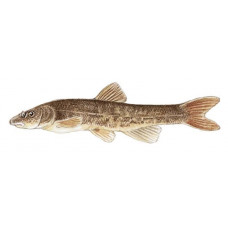Latin name
Rhinichthys cataractae
Other names
French: naseux de rapide
Identification
The longnose dace is a distinctive minnow with a long, fleshy snout, a subterranean mouth and a deep tail stalk. The head and back of the head are slanted away from the cylindrical body, giving this minnow a streamlined appearance. Pigmentation varies greatly. The back can be greenish, brown or reddish purple, while the underside and belly can be silvery, white or yellow. The sides are sometimes marked by darkened scales, a lateral stripe and a patch near the tail. Longnose dace can be easily distinguished from most other minnows by the presence of a bridle, a small fleshy projection between the snout and upper jaw. It can be distinguished from other Rhinichthys species by its long snout. Other characteristics include small antennae at the corner of the mouth, fine scales, a full lateral line with 48-76 scales and eyes closer to the top of the head. The breeding male is red on the head and fins and develops small tubercles on the head, body and pelvic fins.
Distribution
Longnose dace have the widest distribution of any minnow in North America and are an important forage species where they occur in abundance. Several subspecies are known, but further study may reveal unique populations or additional subspecies. The distribution of the longnose dace covers the entire continent, extending across the southern half of Canada and the northern United States. It extends as far south as Georgia within the southern Appalachians and across the Rocky Mountains into northern Mexico. Its northern limit is the Mackenzie River watershed in Canada, which lies beyond the Arctic Circle.
Habitat
Longnose dace can be found in a wide variety of habitats: crevices, clearings and pools of streams, rivers and brooks. Within lakes they usually prefer areas around rocky shores. These streamlined fish are well adapted to fast-flowing water.
Size
Adults can reach over 6 inches in length, but most do not exceed 4 inches. They have been known to live up to 5 years.
Life history and Behavior
Longnose dace mature within 2 years, but can live up to 5 years. Females are often larger and live longer than males. Breeding takes place between late spring and early summer. Interestingly, the eastern subspecies spawns during the day, while the western subspecies spawns at night. Longnose dace are spawners that lay their eggs in shallow, fast-flowing areas and over chub nests. Males aggressively defend spawning sites, but more than one male may line up beside a female during spawning. Spawning takes place on the stream bottom and may result in eggs being buried in the substrate. The female lays between 200 and 1200 eggs during spawning.
Food and feeding habits
Longnose dace feed on aquatic insects (especially midges and blackfly larvae), worms, small crustaceans, mites, algae and plants. They have taste buds on their pelvic fins, lower head, lips and snout, which may allow them to find food at the bottom of streams.
Reproduction
No information
| Classification | |
| Phylum | Chordata |
| Class | Actinopterygii |
| Squad | Cypriniformes |
| Family | Cyprinidae |
| Genus | Rhinichthys |
| Species | R. cataractae |
| Features | |
| Conservation status | Least Concern |
| Habitat | Bottom |
| Life span, years | 5 |
| Maximum body weight, kg | No information |
| Maximum length, cm | 17 |
| Sailing speed, m/s | No information |
| Threat to people | No information |
| Way of eating | Bentophage |

